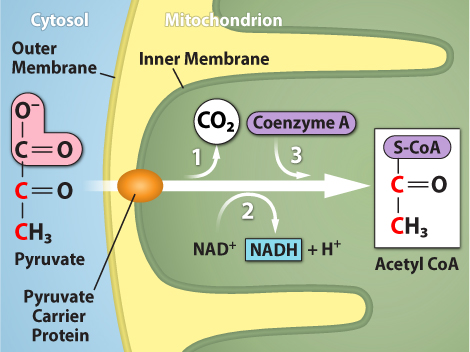Chapter 12: Cellular Respiration
12.3. Citric Acid Cycle and the Preparatory (or Intermediate) Step
Learning Objectives
By the end of this section, you will be able to:
- Explain how a circular pathway, such as the citric acid cycle, fundamentally differs from a linear biochemical pathway, such as glycolysis.
- Describe how pyruvate, the product of glycolysis, is prepared for entry into the citric acid cycle.
Preparatory or intermediate step: pyruvate oxidation
If oxygen is available, the 3-Carbon pyruvates are transported into the mitochondrial matrix where in each molecule a C atom is removed, resulting in CO2 and 2-Carbon acetyl. Acetyl contains a carbonyl and a methyl functional group and is denoted as R−C(=O)−CH3 .
The acetyl is picked up and activated by a carrier called coenzyme A (CoA), forming a compound called acetyl CoA. CoA requires dietary intake of vitamin B5 (pantothenic acid) for its synthesis. Acetyl CoA’s major function in cellular respiration is to deliver the two-Carbon acetyl group to the citric acid cycle (Figure 12.3.1.).

The end-products are pyruvate oxidation are:
- 2-Carbon Acetyl CoA
- CO2 , the first waste product formed in cellular respiration
- NADH, the high energy electron and H+ carrier derived from reduction of NAD+
Since there are two pyruvate molecules formed from each glucose molecule, this step occurs twice.
Citric acid cycle
The citric acid cycle is also called the Krebs cycle (after its discoverer) and the tricarboxylic acid cycle (TCA), named for the first molecule in the cycle.
The Krebs cycle takes place in the mitochondrion matrix in the presence of Oxygen. Acetyl CoA delivers its acetyl group to a 4-Carbon molecule, oxaloacetate, the last molecule of the cycle. The 2-Carbon acetyl plus the 4-Carbon oxalacetate form 6-carbon citric acid (TCA), the first molecule of the cycle.
There are eight steps of the citric acid cycle involving a series of redox, dehydration, hydration, and decarboxylation reactions (Figure 12.3.2.).
The end-products of the Krebs cycle are:
- waste product, CO2, (from each 2-Carbon acetyl groups)
- ATP (after conversion from another nucleotide guanosine-5′-triphosphate,GTP)
- NADH, reduction product of coenzyme NAD+
- FADH2, reduction product of a second coenzyme FADH (also derived from vitamin B)
Note that the Krebs cycle is considered an aerobic pathway. Although the reactions do not directly use O2, its two reduced coenzymes, NADH and FADH2, will transfer their electrons and H+ to Phase 3 (Oxidative Phosphorylation) which does directly use O2.

License and attributions:
- Biology, Second edition, 2018, Clark, M.A. et al. License: CC BY 4.0. Located at https://openstax.org/books/biology-2e/pages/7-3-oxidation-of-pyruvate-and-the-citric-acid-cycle
